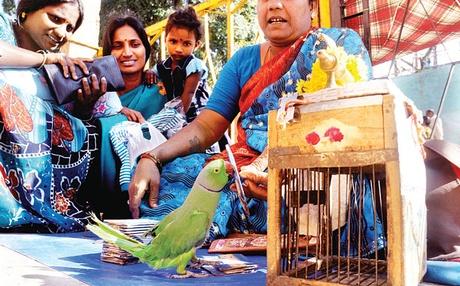Traditions - Fortune-telling parrots

The “astrologer parrots” or “fortune-teller parrots” are mostly found in the Tamil Nadu area in India, in the Little India district in Singapore. This practice involves the use of trained parrots to choose a card in order to predict the future of their customers. In Pakistan, despite the fact that divination is a practice forbidden by the most orthodox Islam, the history of the country under Indian control means that the use of these animals is still prevalent in certain areas of its geography.
Normally a fortune-teller will have one or two parrots in a cage that will be released when a client requests his services. These animals are trained to take a card, give it to the owner under his orders and return to the cage. Tradition says that the parrot chooses the card based on the client's name or date of birth. The animal passes cards until it "feels" that it finds the appropriate one for the client. The astrologer interprets the card chosen by the parrot and makes the corresponding prediction.
Training and deprivation
Although it is a decreasing activity, the training of parrots that continue to be used for this purpose is an undeniable form of abuse.
The nature of parrots is known as neophobia, that is, the fear of new things. Their natural behavior is to fly away, so the maintenance of these birds goes throughthe mutilation of one of the joints of the wings, known as pinioning.
The confinement of the parrots in small cages inhibits their natural behavior. The training for the choice of cards is done through food deprivation.
An illegal activity in India
In India, despite being an illegal activity since the entry into force of the Wildlife Protection Act in 1972, the practice still persists in certain communities. Entities such as the Visakha Society for the Protection and Care of Animals or the World Parrot Trust have made public the status of numerous animals that have been confiscated and rescued and that, after a rehabilitation process, have been released into the wild.
Singapore, persistence of tourism
Fortune-teller parrots are also disappearing in Singapore but they still persist in certain areas as a tourist reclaim, where for only 5 dollars soothsayers continue to use these animals as a lure. An example of this is the case of Maní, a parrot that guessed the results of the 2010 FIFA World Cup quite accurately. His fame led to an increase in demand for his predictions, which multiplied and raised both his price and the stress on his living conditions.
